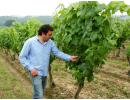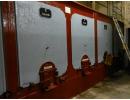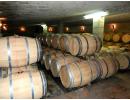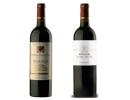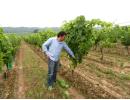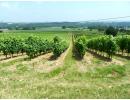Domaine Berthoumieu
Domaine Berthoumieu "Charles de Batz" 2014 - Madiran
This is the premium wine of the Domaine. The blend is 90% Tannat with 10% Cabernet Sauvignon from 50 to 100 years old vines. The yield is low at 38 hl/ha. The grapes are destemmed before the fermentations and the 2 grape varieties are fermented separately: 4 weeks for the Tannat and 3 weeks for the Cabernet Sauvignon. During the fermentation in concrete vats of 50 to 80 hl some micro-oxygenation is carried out to soften the tannins a little and increase the aromas. Following the fermentations, the Tannat and Cabernet will be blended and aged for 22 months: 4 months in vats then 12 months in oak barrels with 50% new and 50% one year old, then a further 6 months in concrete vats to allow the wine to rest and settle before bottling with a light filtration.
PVins notes: The wine's colour is deep red almost black, the nose is complex with spices and notes of blackberries and prune with hints of mocha. The wine is well structured, with a good concentration of tannins that are well integrated. It is recommended to cellar the wine for 3-4 years before opening a bottle, the alternative if you cannot wait is to decant the wine for a couple of hours. The wine may be cellared for 15+ years.
Wine Enthusiast 93
This is a bold, structured and firm wine, full of dark tannins and ripe fruit. It has power and a dark presence that comes from the dense texture and the dry core that is still a powerful element in the wine. That means that the wine needs to age further. Drink from 2021.
Guide Hachette des Vins 2018 Excellent ⭐⭐🧡
Cuvée Charles de Batz defends itself once more with panache. The deep colour robe still shows purplish reflections of its youth. Intense and rich, the nose combines noble wood, vanilla, licorice and jammy black fruit aromas. Combined strength and elegance, great freshness, the palate is fleshy supported by tight tannins. What class!
Domaine Berthoumieu "Vitis MCM" 2012 - Madiran
A super premium cuvée made since 2007. Produced with 100% Tannat from the oldest vines planted in 1900 (Roman numerals MCM) from a parcel of 0.80 ha, the yield's average is 25 to 28 hl/ha. The grapes are de-stemmed before a skin maceration that will last 3 days at 12°C, then fermentations will last about 30 days in concrete vats of 50 hectolitres. The wine is aged for 18 months which includes 12 months in new french oak barrels of 228 litres and a further 6 months in concrete vats, allowing the wine to rest and settle before bottling without filtration.
PVins notes: Its colour is deep red to black, expressive nose of blackberries and plums, it's masculin and powerful, well structured and balanced by the acidity, the finish is complex and long. This is a wine that requires a few years of cellaring and will last a couple of decades.
Wine Enthusiast 95
Produced from vines planted in 1900 (MCM in Roman numerals), this is a serious, major wine. It is so concentrated with its dark tannins yet never loses its elegant balance between fruit and structure. Dense dusty dry tannins are layered with black plum and damson flavors giving a surprising freshness to a wine that is still young. Drink from 2022.
Domaine Berthoumieu is located at Viella in the lieu-dit "Dutour" situated in the northern part of the Madiran appellation in the Gers department. Since 1850, Didier BARRE was the 6th generation on the estate after taking over the winemaking from his father Louis in the mid-80’S. Didier studied oenology in Bordeaux and produced high quality Madirans with great passion and knowledge of the terroir. In early 2017 Didier retired from the estate as it was purchased by the sisters Claire and Marion Bortolussi. Their aim is to keep Domaine Berthoumieu at its highest level with a feminin touch.
The Domaine’s vineyards cover 26 ha, planted with vines aged from 10 to 100 years old set on a plateau and hillsides. The red grapes cover 22 ha with the Tannat as the dominant varietal representing 2/3 of the vineyard, followed by Cabernet Sauvignon, Cabernet Franc and a little of Pinenc (Fer Servadou). The white grapes Gros Manseng, Petit Manseng and Petit Corbu represent 4 ha. The local terroir varies from clay and gravel to clayey-limestone with gravel from alluvial deposits.
Sustainable farming and qualitative growing techniques are implemented with the passion of producing high quality wines. Vine management is ensured through various practices undertaken in the vineyard such as leaf thinning to get the best maturation possible, green harvesting to limit yields and enhance the quality of the grapes. The harvest is hand-picked.
For the winemaking process, the different red grape varieties are de-stemmed and fermented separately in concrete vats for several weeks. The vats vary in size 50 and 80 hl depending on the size of the plot. During the fermentations with indigenous yeasts a little micro-oxygenation will be done to soften the tannins and increase the aromas. Both red and white wines are aged in the underground cellar where they undergo malolactic fermentations. The different cuvées are aged in oak barrels and concrete vats depending on the style of the wine. Since taking over the winemaking in the 80’s, Didier has been using Burgundian size oak barrels of 228 litres for the winemaking process.
Domaine Berthoumieu produces different styles of wines that are considered amongst the best of Madiran. Three Madiran red wines are produced with the main wine of the Domaine named "Haute Tradition" comprising 60% Tannat blended with Cabernet Sauvignon and Pinenc. It is partially aged in oak and made for early drinking. This is a medium cellaring style of wine.
But the Domaine's reputation comes from its well-known premium Madiran "Cuvée Charles de Batz", made with 90% Tannat and cabernet Sauvignon from 50 to 100 years old vines from the best parcels. The purpose of the Cabernet Sauvignon in the blend is to round off the tannins of the Tannat. The wine is aged in oak barrels for 12 months of which 50% are new, then it will spend a further 6 months in concrete vats to allow the wine to rest and settle before bottling with a light filtration if necessary. The wine is named after the famous Musketeer D’Artagnan, born in the region he served the French King Louis XIV in the 17th century and was killed on the battlefield in Holland in June 1673.
In 2007 Didier decided to produce a new super premium cuvée "VITIS MCM" made with 100% Tannat from the oldest vines planted between 1900 - 1925, giving the wine its name using the Roman numerals MCM. The parcel only represents 0.80 ha with the yields averaging 25 to 28 hl/ha. Once the grapes have been hand-picked and destemmed the skins are macerated for 3 days at about 12°C to extract extra coulour, tannins and flavours. The fermentations last about 30 days in concrete vats. The following February the wine is tranfered in to new french oak barrels for 12 months after which it will spend a further 6 months in concrete vats to allow the wine to rest and settle. The wine is bottled without filtration.
Didier also produces 2 white wines. A dry Pacherenc du Vic-Bilh Sec "Les Pierres de Grès" based on Gros Manseng grapes produced from 50 years old vines, the wine is partially fermented and aged in oak. The late harvest Pacherenc du Vic-Bilh Moelleux "Symphonie d'Automne" is made from 50 years old vines comprising a blend of 90% Petit Manseng and 10% Petit Corbu. The wine is fermented and aged in new oak barrels. These 2 wines show great aromatic complexity of citrus fruits and white flowers with exotic confit fruits for the dessert wine a result of the "passerillage" effect on the grapes. The wines are also well-balanced by the natural acidity.
Since 2000, the Domaine also produces a rare red fortified (VDN) wine named "Tanatis". The old Tannat grapes come from the same parcel as the cuvée "MCM". They are harvest a month later to enable the sugar to increase in the grains, the low yield produced in about 17hl/ha. The wine is made with the same principals as a red Banyuls from the Roussillon region. The fermentations are stopped by adding grape spirit, called "mutage", which representing about 3% of the must volume. The process will increase the alcohol content to 17.5% and retain a residual sugar of 100g/l in the wine. The fermentations in concrete vats before the mutage will last 3 to 4 weeks at 14°C, giving the wine time to reach a natural alcohol content of 14°C. The wine is aged in french oak barrels of 225 litres for 24 months, the barrels are 2 to 3 years old.
French version
Links: South-West map - www.madiran-story.fr
MADIRAN
The appellations Madiran and Pacherenc du Vic Bilh were created in 1948. They are located in the South-West of France about 100 kilometres inland from the Atlantic Ocean and about 60 kilometres north of the Pyrenees Mountains. The appellations spread over 37 communes in 3 départements: Gers, Hautes-Pyrénées and Pyrénées-Atlantiques.
History
Viticulture in the region dates back to the Roman times around the 1st century BC. In the 11th century, the Benedictine monks from the village of Madiran produced wines which were mainly consumed by the locals and throughout the region. The red wine was known for its rustic tannic structure and was used to strengthen other red wines in poor vintages. The wine of Madiran also became famous as it was consumed by the pilgrims on their route to Saint Jacques de Compostelle. In the 17th century, the Madiran and Pacherenc du Vic Bilh wines were exported to northern Europe via the port of Bayonne after being transported down the Adour River. The Dutch were known to appreciate the sweet white wines. Unfortunately, the vineyards fell into disarray following the Phylloxera in the 19th century and later the effect of the Second World War, most of the vineyards had disappeared and only a few hectares remained. With the determination and motivation of a few vignerons, vineyards were replanted and structured to produce quality wines, this initiative enabled the wines of Madiran and Pacherenc du Vic Bilh to reach AOC status in 1948. Today the high quality of the Madiran wine is well-known around the world for its dark colour, aromatic complexity and tannic structure.
Vineyard
The Madiran and Pacherenc du Vic Bilh appellations share the same area around the village of Madiran. The red wines of Madiran represent 1,260 hectares and the white wines of Pacherenc du Vic Bilh cover 280 hectares. The appellations' vineyards are set on the left bank of the Adour River that flows from the Pyrenees into the Atlantic Ocean at Bayonne. The area is organised into 4 main ridge lines on the Pyrenean foothills, running north to south with altitudes varying from 180 to 400 meters, the slopes face either towards the west or the east. The range of terroirs are:
- On the well-exposed hilltops, smooth pebbles are found providing well-drained soils, they also retain heat from the sun and help in the maturity of the grapes yielding silky wines.
- The stony steep slopes are made of clay-limestone and are also well-drained, this terroir is amongst the best of the appellation producing wines that are well-structured with good ageing potential.
- The intermediate flats are composed of clay: these are light, permeable soils that heat up quickly, giving supple easy-to-drink wines. Depending on the area, these clays can be beige, red, gravel or alios-based.
- The hotter south-west facing slopes are planted in red grapes, while the white grapes are planted on cooler clayey slopes.
Here the Tannat grape is the main varietal covering 70% of the appellation but other varieties such as Cabernet Franc (20%), Cabernet Sauvignon (9%) and Fer Servadou also named Pinenc (1%) are also grown and often used in the blending. A Madiran wine must have at least 40% of Tannat, while premium wines produced usually have a very high portion of Tannat with some made from Tannat only. As per the appellation's regulation, the red wines have to be aged for a minimum of 12 months before release, oak is often used especially for the premium wines. Usually the main range of Madiran wines are called “Tradition”. These are intense, fresh and fruity wines that are pleasant to drink early. The premium wines are Tannat dominant, they are powerful and elegant, marked by aromas of toast, leather, liquorice and spices. They require a few years of cellaring for the tannins to smooth out a little even though a small portion of cabernets are often used to round off the Tannat's tannins.
As for the Pacherenc du Vic Bilh, the main white grapes varieties are Gros Manseng, Petit Manseng, Petit Courbu and Arrufiac which can be blended with Sauvignon Blanc and Semillion but these 2 varieties cannot exceed 10% of the blend. Both dry (sec) and sweet (moelleux) wines are produced, they represent a small volume of the local wine production.
Climate
The region benefits from an oceanic climate. There are however specific microclimates that can be explained by the influence of three factors: the proximity of the Atlantic Ocean, the proximity of the Pyrenees Mountains and the proximity of the Gascony region with its more continental climate. These natural elements create a certain climatic complexity. Winters are generally mild with rainfalls (1000mm per year) concentrated in the spring and summer. Autumns are warm and dry, often characterised by wide temperature variations and by the Foehn effect, a warm southerly wind coming over the Pyrenees from Spain, which encourages optimal maturation of the grapes.




